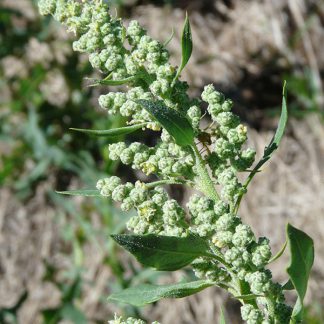significant
Showing 1–12 of 46 results
-

Agropyron cristatum / crested wheatgrass
- cool season grass growing in dense tufts
- easily recognized by planar spike
- spikelets overlap and are angled with respect to the stem
- common
-

Allium geyeri / Geyer’s onion
- smells like onions
- magenta (occasionally white) flowers on ca. 15 inch stem
- each flower urn-shaped with flared, pointy tips; yellow anthers
- leaves persistent during flowering
- rocky slopes in brush and pines, sometimes in dense stands
-

Anaphalis margaritacea / pearly everlasting
- hairy leaves and stems, often in dense colonies
- inflorescences dominated by white involucral bracts
- actual flowers are small, yellow and in the center
- commonly on dry soils
- great for dried flower arrangements
-

Artemisia cana / silver sagebrush
- Low perennial, silvery shrub
- Highly aromatic, like sagebrush
- Entire leaves - no lobes
- Nondescript, inconspicuous flowers in small clusters with leaf-like bracts
- Grows in more moist habitat than other Artemisia spp.
-

Artemisia rigida / stiff sagebrush
- low growing deciduous shrub
- short, 3-5 lobed, grey leaves (hairy)
- mild to pungently aromatic leaves
- brittle branches up to 16 inches long
-

Artemisia tripartita / threetip sagebrush
- evergreen shrub; branches in broom-like clusters
- all parts covered with silvery/grey-green glandular hairs
- leaves long and very deeply, very distinctly 3-lobed
- flowers in spikes/racemes - all bits teeny, overall yellow-ish/reddish
- often with mountain big sagebrush on nutrient poor soils
-

Beteroa incana / hoary alyssum
- dense clusters of teeny white flowers
- 4 petals, each with a notch
- fruit is a short, fat-ish seed pod (silicle)
- found in pastures and all manner of disturbed habitats
- toxic to horses
-

Bistorta bistortoides / American bistort
- rocky areas, tundra/alpine
- inflorescence a 2" dense cylinder with many teeny white flowers
- notable protruding stamens
- leaves basal, long/thin and leathery
-

Bromus inermis / smooth brome
- clump forming grass but clonally spreading
- erect, leafy
- in winter, leaves curl up (like ribbon)
- florescence is a nodding panicle, standing well above leaves
- spikelets bronze/purple at maturity; anthers yellow
-

Castilleja spp. / two yellow paintbrushes
- look like Indian paintbrushes (which they are), but yellow
- inflorescence bracts possibly lobed
- height ranges from less than 8" to about 15"
- subalpine, alpine and tundra habitats, in clumps or spread out
- linear leaves without lobes, 3 prominent veins
- red to maroon, hairy stems
-

Chenopodium album / lamb’s quarters
- green, nobbly inflorescence - many nob-like flowers
- leaves grey-green, more or less triangular
- leaves may feel cool to the touch
- widespread weed, especially in disturbed habitats
-

Cirsium vulgare / bull thistle
- very nasty spines all over, including stems
- purple flower head over pear/egg-shaped narrow, spiny bracts
- fruits are thistle-downy
- disturbed areas, but also forest gaps, stream sides and seeps
Showing 1–12 of 46 results